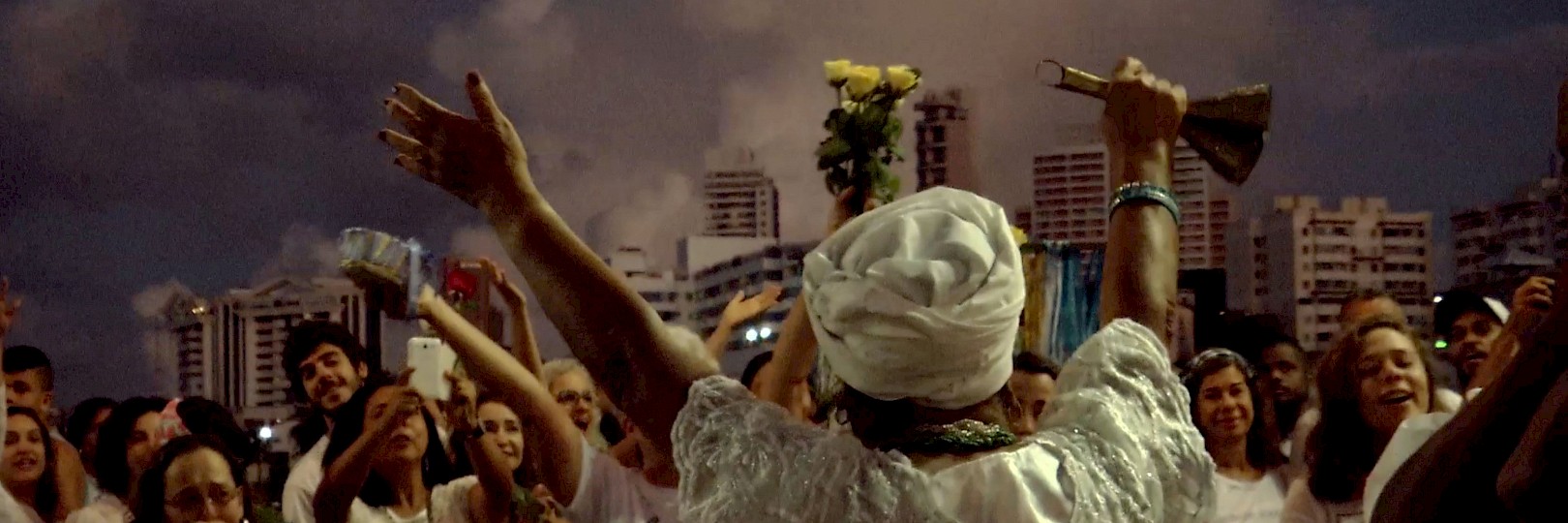Festa de Iemanjá
20:08
Iemanjá Festivities. Candomblé. Umbanda. Catholicism. Afro Brazil. Mother Aíce de Oxóssi. Terreiro Odé Mirim. Salvador. Bahia state. February 2nd, 2015. 1 million people in attendance
The Day for Iemanjá
It’s the sea, the sea. Covered with scented flowers and mirrors. These are the same waters that run through a certain Rio Vermelho (Red River, literally) in the conluence in the fisherm’s Sant’Ana and the Queen of the blakc men’s Sea in Bahia state, said to be blessed by Saint Salvador, but which really is blessed by All Saints. The address for the beach where the celebration takes place goes by the name of Paciência (patience).

The Great Mother to all orixás and all waters, is fertility for her children, who are like fish that need to learn how to navigate. Mother, too, to rafters and fishermen, men of early labour who started this celebration in the first place. About one hundred years ago, a thing for those who are determined to understanding the state of Bahia. First of all, they are the ones offering their faith in prayers for the Saint who emerged from the waters to protect them.
“Iemanjá
Queen of the waves
Mermaid of the sea.”
Song to Iemanjá

Enclosed in their terreiros, Candomblé followers perform their rituals for the water orixás. In Salvador city, every gift to the Queen of the Sea is preceded by one to the Queen of Spring Waters: it is for Oxum, in yellow, that the fisrt celebration at Dique Tororó takes place, in the morning from August 1st to 2nd on the second month of the year.
Dressed in white, standing life someone who knows how to revere their predecessors. They later take the the city’s streets, singing with hampers-full of offerings to Iemanjá: many colored flowers for Odoyá!

“Many people ask her for gifts and get them.
She feels happy to see those hampers.”
Mother Aíce de Oxóssi at Terreiro Odé Mirim
Once all the feet are standing firmly on the same sand, boaters and macumbeiros and Catholic and party-goers arrive. Fireworks at dawn teach us how to handle emotions. Clapping hands, atabaques, songs, and praise: more and more beads turn up for a shared story of meetings. In that particular year, Mother Aíce was responsible for the main gift to Iemanjá: offerings filled with secrets, prepared over tiruals lasting up to seven days, based on the fundamentals of Axé.

The body shivers, the eye-sight darkens. Incorporations and trances emerge in circles. These are the people of the Saints who don’t want to miss out on an oppportunity to thank for another February 2nd! With capoeira moves, hand in hand, lit candles, and whispers, one can almost hear all these people asking for the same: what can we do so we don’t give up on loving, mother?
With a question such as this thrown into air and sea, the whole city wakes up. And Profane meets Sacred on those steep streets that are so used to celebration. It’s marching bands, just like in Carnaval, that turn up the volume of prayers spreading throughout the neighborhood beyond the sand.

“I’m Brazilian: I like to party and I’ve been a macumbeira since birth.”
Mother Aíce de Oxóssi at Terreiro Odé Mirim
The sun is one of the first to show it’s time to go. The waters glimmer as those same fishermen leave on their boats with the offerings. She turns up, splashing the aromatic water prepared by so many hands to greet her; making hearts pulse to the echo of the atabaques, while eyes meet and know: there is overflowing faith.

interview
Mateus Aleluia
09:43
